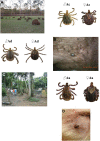Ecology, biology and distribution of spotted-fever tick vectors in Brazil
- PMID: 23875178
- PMCID: PMC3709097
- DOI: 10.3389/fcimb.2013.00027
Ecology, biology and distribution of spotted-fever tick vectors in Brazil
Abstract
Spotted-fever-caused Rickettsia rickettsii infection is in Brazil the major tick-borne zoonotic disease. Recently, a second and milder human rickettsiosis caused by an agent genetically related to R. parkeri was discovered in the country (Atlantic rainforest strain). Both diseases clearly have an ecological background linked to a few tick species and their environment. Capybaras (Hydrochoerus hydrochaeris) and Amblyomma cajennense ticks in urban and rural areas close to water sources are the main and long-known epidemiological feature behind R. rickettsii-caused spotted-fever. Unfortunately, this ecological background seems to be increasing in the country and disease spreading may be foreseen. Metropolitan area of São Paulo, the most populous of the country, is embedded in Atlantic rainforest that harbors another important R. rickettsii vector, the tick Amblyomma aureolatum. Thus, at the city-forest interface, dogs carry infected ticks to human dwellings and human infection occurs. A role for R. rickettsii vectoring to humans of a third tick species, Rhipicephalus sanguineus in Brazil, has not been proven; however, there is circumstantial evidence for that. A R. parkeri-like strain was found in A. ovale ticks from Atlantic rainforest and was shown to be responsible for a milder febrile human disease. Rickettsia-infected A. ovale ticks are known to be spread over large areas along the Atlantic coast of the country, and diagnosis of human infection is increasing with awareness and proper diagnostic tools. In this review, ecological features of the tick species mentioned, and that are important for Rickettsia transmission to humans, are updated and discussed. Specific knowledge gaps in the epidemiology of such diseases are highlighted to guide forthcoming research.
Keywords: Brazil; Rickettsia; ecology; human spotted-fever; tick species.
Figures



References
-
- Angerami R. N., Resende M. A., Feltrin A. F. C., Katz G., Nascimento E. M., Stucchi R. S. B., et al. (2006). Brazilian spotted fever: a case series from an endemic area in southeastern Brazil. Ann. N.Y.Sci. 1078, 252–254 - PubMed
-
- Angerami R. N., Silva A. M. R., Nascimento E. M. M., Colombo S., Wada M. Y., Santos F. C. P., et al. (2009). Brazilian spotted fever: two faces of a same disease. A comparative study of clinical aspects between amn old and a new endemic area in Brazil. Clin. Microbiol. Infec. 15(Suppl. 2), 207–208 10.1111/j.1469-0691.2008.02160.x - DOI - PubMed
Publication types
MeSH terms
LinkOut - more resources
Full Text Sources
Other Literature Sources

